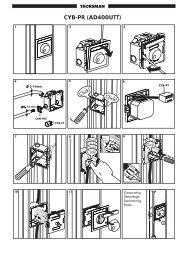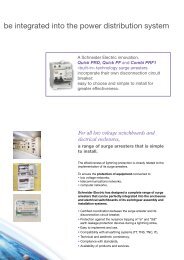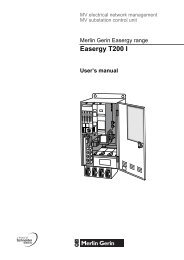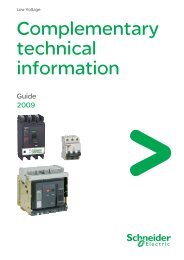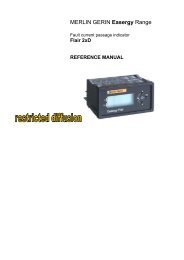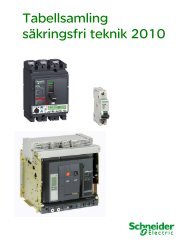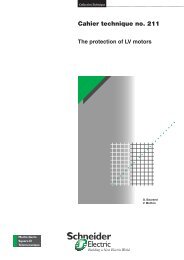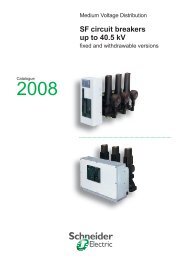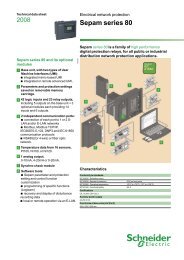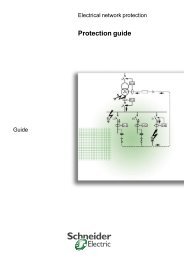VIP30 and VIP35 - Schneider Electric
VIP30 and VIP35 - Schneider Electric
VIP30 and VIP35 - Schneider Electric
Create successful ePaper yourself
Turn your PDF publications into a flip-book with our unique Google optimized e-Paper software.
0<strong>Electric</strong>al network protection<br />
0<strong>VIP30</strong> / <strong>VIP35</strong><br />
0User<br />
0manual<br />
02004
Contents<br />
Functions <strong>and</strong> characteristics<br />
Presentation of <strong>VIP30</strong> <strong>and</strong> <strong>VIP35</strong> relays 2<br />
Presentation of CRc <strong>and</strong> CEc sensors 3<br />
Description of <strong>VIP30</strong> <strong>and</strong> <strong>VIP35</strong> relays 4<br />
Presentation of the VAP6 test unit 6<br />
Using the VAP6 test unit 7<br />
Technical characteristics 8<br />
Installation <strong>and</strong> connection<br />
Mounting 10<br />
Connection 12<br />
1
Functions <strong>and</strong><br />
characteristics<br />
Presentation of <strong>VIP30</strong> <strong>and</strong> <strong>VIP35</strong><br />
relays<br />
DE50894<br />
Simplified wiring diagram.<br />
Self-powered protection relays<br />
<strong>VIP30</strong> <strong>and</strong> <strong>VIP35</strong> relays are designed for use in power distribution systems, mainly<br />
in MV/LV substations where they provide protection upstream from the transformer.<br />
They are self-powered relays (supplied by current sensors) requiring no auxiliary<br />
power supply.<br />
They actuate a Mitop release.<br />
The <strong>VIP30</strong> provides protection against phase-to-phase faults.<br />
The <strong>VIP30</strong> WED has the same characteristics as the <strong>VIP30</strong>. The only difference<br />
concerns the markings on the setting label.<br />
The <strong>VIP30</strong> WED settings depend on the power rating.<br />
The <strong>VIP35</strong> provides protection against phase-to-phase <strong>and</strong> earth faults.<br />
DE10326<br />
Phase protection<br />
Phase protection uses an IDMT set point equal to 1.2 times the current setting (Is).<br />
The <strong>VIP30</strong> <strong>and</strong> <strong>VIP35</strong> phase protection functions are the same.<br />
<strong>VIP30</strong> <strong>and</strong> <strong>VIP35</strong> phase protection.<br />
DE50896<br />
Earth fault protection<br />
Earth fault protection is based on residual current measurements using the sum of<br />
the sensor secondary currents. Measurements are carried out by a CSH30 core<br />
balance CT mounted on the back of the <strong>VIP35</strong> unit. Earth fault protection operates<br />
according to definite time characteristics; the set point <strong>and</strong> time delay are adjustable.<br />
<strong>VIP35</strong> earth fault protection.<br />
Equipment description<br />
The <strong>VIP30</strong> <strong>and</strong> <strong>VIP35</strong> relays are mounted in an injected polycarbonate casing that<br />
protects them against dripping water <strong>and</strong> dusty environments.<br />
The front is protected by a transparent cover fitted with a sealing gasket.<br />
The cover may be lead-sealed to protect access to the settings.<br />
Rotary selector switches are used for settings. The phase <strong>and</strong> earth fault current<br />
settings are made directly in amperes. This means that the graduations on the front<br />
must be adapted to suit the sensor range used. This is done by fitting the appropriate<br />
setting label when mounting the relay.<br />
The connection is made on the back of the relay using fast-on type connectors.<br />
2
Functions <strong>and</strong><br />
characteristics<br />
Presentation of CRc <strong>and</strong> CEc<br />
sensors<br />
To obtain the indicated performance characteristics, <strong>VIP30</strong> <strong>and</strong> <strong>VIP35</strong> relays must<br />
be used with the specified sensors. The relay/sensor assemblies are defined to<br />
respect the technical characteristics indicated, in particular:<br />
operation over the entire range<br />
tripping time<br />
accuracy<br />
short-circuit thermal withst<strong>and</strong>.<br />
The same type of sensor must be used on each phase.<br />
CRc <strong>and</strong> CEc sensors for <strong>VIP30</strong>/<strong>VIP35</strong>:<br />
CRc 200/500/1 sensors are used on RM6 units (models since 1998).<br />
CEc 200/500/1 sensors are used on 24 kV Evolis integrated circuit breakers.<br />
CRc <strong>and</strong> CEc sensors have two secondary windings.<br />
DE50902<br />
The wiring of the sensor secondary windings determines the <strong>VIP30</strong>/<strong>VIP35</strong> current<br />
setting range.<br />
Current setting range Ratio Wiring<br />
8A - 80 A 200 / 1 S1 - S2<br />
20A - 200A 500 / 1 S1 - S3<br />
The cross-section of the core <strong>and</strong> the resistance of the winding are chosen so as to<br />
protect the <strong>VIP30</strong>/<strong>VIP35</strong> in the event of a high fault current <strong>and</strong>/or a short-circuit on<br />
the MV system.<br />
3
Functions <strong>and</strong><br />
characteristics<br />
Description of <strong>VIP30</strong> <strong>and</strong> <strong>VIP35</strong><br />
relays<br />
a<br />
DE50897<br />
<strong>VIP30</strong> front panel.<br />
DE50899<br />
<strong>VIP30</strong>/<strong>VIP35</strong> phase protection<br />
1: phase protection zone<br />
Information concerning phase protection is presented in the dark zone at the top of<br />
the front panel. This zone is the same for the <strong>VIP30</strong> <strong>and</strong> <strong>VIP35</strong>.<br />
2: current setting Is<br />
Time-delayed tripping of the phase protection takes place at 1.2 x Is.<br />
Depending on how the sensors are wired, the current setting is adjustable from<br />
8A to 80A or from 20A to 200A; the selector switch graduations are adapted to the<br />
range by fitting the appropriate setting label.<br />
Other <strong>VIP30</strong>/<strong>VIP35</strong> functions<br />
a: setting label<br />
The setting label should be fitted on the <strong>VIP30</strong>/<strong>VIP35</strong> when it is mounted on the<br />
circuit breaker. The label indicates the graduations of the phase current setting<br />
(<strong>VIP30</strong>/<strong>VIP35</strong>) <strong>and</strong> earth protection setting (<strong>VIP35</strong>) selector switches. It is inserted,<br />
from the top, behind the transparent part of the front panel.<br />
How to fit the setting label.<br />
b: sensors used <strong>and</strong> wiring<br />
The text is printed on the setting label. It indicates the secondary winding of the CRc<br />
or CEc sensors used to give the desired setting range.<br />
When the label is in position in the slot, the text is hidden by a non-transparent zone.<br />
It is not visible to the user.<br />
DE50917<br />
c: VAP6 test plug<br />
The test plug is exclusively designed for connection of the VAP6, used for fast <strong>and</strong><br />
easy relay testing.<br />
The test may be carried out during normal operation of the installation since the<br />
VAP6 <strong>and</strong> <strong>VIP30</strong>/<strong>VIP35</strong> provide the possibility of testing without circuit breaker<br />
tripping.<br />
The test is possible even if the relay is not supplied by the sensors. In that case, the<br />
VAP6 supplies the <strong>VIP30</strong>/<strong>VIP35</strong>.<br />
Testing the <strong>VIP30</strong>/<strong>VIP35</strong> with the VAP6.<br />
d: minimum time delay switch<br />
The circular opening on the front face provides access to a switch used to delay the<br />
tripping order by at least 25 ms. The time delay may be enabled to prevent the circuit<br />
breaker from breaking at the beginning of the asymmetrical phase in the event of a<br />
high fault.<br />
It should be enabled or disabled depending on the type of circuit breaker. The user<br />
does not have access to the time delay switch since the opening is hidden by the<br />
setting label.<br />
4
Functions <strong>and</strong><br />
characteristics<br />
Description of <strong>VIP30</strong> <strong>and</strong> <strong>VIP35</strong><br />
relays<br />
DE50901<br />
<strong>VIP35</strong> front panel.<br />
<strong>VIP35</strong> earth protection<br />
4: earth protection zone<br />
This zone contains the earth protection settings.<br />
5: earth protection setting<br />
The setting is made directly in MV amperes.<br />
6: earth protection time delay<br />
The earth protection time delay is set in seconds.<br />
When the circuit breaker closes, energizing of the MV/LV<br />
transformer may generate aperiodic inrush currents with a DC<br />
component that momentarily saturates the magnetic cores of<br />
the <strong>VIP35</strong> sensors.<br />
Consequently, each sensor gives an erroneous result <strong>and</strong> the<br />
sum of the phase currents (at the sensor secondary windings)<br />
is no longer zero. This gives rise to a false earth fault detection<br />
<strong>and</strong> can cause unnecessary tripping of the earth protection.<br />
This is especially critical for low earth protection current <strong>and</strong><br />
time-delay settings.<br />
If the earth protection time-delay setting is below the value<br />
indicated in the table below for the current setting used, the<br />
inrush current delay time delay should be enabled.<br />
Io> setting<br />
to> time delay<br />
0.8 to 0.9 x Ia 0.2 s<br />
0.6 to 0.8 x Ia 0.3 s<br />
0.4 to 0.6 x Ia 0.4 s<br />
0.2 to 0.4 x Ia 0.5 s<br />
Ia: rated current of the transformer to be protected.<br />
7: inrush current delay<br />
This selector switch is used to enable the inrush current delay (1s). The time delay<br />
prevents the earth protection from tripping when the <strong>VIP35</strong> is energized upon circuit<br />
breaker closing. The time delay only applies to the earth protection <strong>and</strong> has no effect<br />
on tripping by the phase protection.<br />
In "off" position, the inrush current delay is disabled. The earth protection operates<br />
according to the delay set on the selector switch (6).<br />
In "on" position, the inrush current delay is enabled.<br />
In this case:<br />
when the <strong>VIP35</strong> is energized, <strong>and</strong> the circuit breaker is closed, tripping by the earth<br />
protection is delayed by 1 second<br />
when the <strong>VIP35</strong> has been supplied for more than a second, the earth protection is<br />
delayed according to the setting (6).<br />
5
Functions <strong>and</strong><br />
characteristics<br />
Presentation of the VAP6 test unit<br />
DE50916<br />
The VAP6 is a portable unit that can be connected to the <strong>VIP30</strong>/35 to carry out<br />
simplified testing.<br />
The test can be carried out in the following two cases:<br />
the <strong>VIP30</strong>/<strong>VIP35</strong> is already supplied by the sensors<br />
the <strong>VIP30</strong>/<strong>VIP35</strong> is not supplied; in this case the VAP6 batteries supply power to<br />
the relay.<br />
The test consists of:<br />
injecting a stimulus to simulate a phase fault<br />
injecting a stimulus to simulate an earth fault (<strong>VIP35</strong>)<br />
checking tripping (refer to the description of the test in the section entitled "test<br />
sequence").<br />
The VAP6 is supplied by batteries. Therefore the parts of the <strong>VIP30</strong>/<strong>VIP35</strong> that<br />
require AC current are not checked using this method (input <strong>and</strong> supply circuits).<br />
Push-buttons<br />
Battery test: if the batteries are OK, the "on" indicator lights up while the button is<br />
pushed.<br />
Phase overcurrent: it sends the phase protection test stimulus. The stimulus is<br />
equivalent to 20 times the current setting Is.<br />
Earth fault: it sends the earth protection test stimulus. The stimulus is equivalent<br />
to a current greater than the highest of the Io> settings.<br />
Trip inhibition: press the "trip inhibition" button if the <strong>VIP30</strong>/<strong>VIP35</strong> test should be<br />
carried out without tripping of the circuit breaker. Circuit breaker tripping is disabled<br />
while the 'trip inhibition" button is pressed, even if the tripping order results from a<br />
real fault.<br />
VAP6 front panel.<br />
Indicators<br />
On: indicates that the batteries are operational. Also lights up when the battery test<br />
is carried out by pressing "battery test".<br />
Test in progress: confirms sending of the test stimulus to the <strong>VIP30</strong>/<strong>VIP35</strong>.<br />
Trip:lights up when the <strong>VIP30</strong>/<strong>VIP35</strong> sends a trip order (whether or not circuit<br />
breaker tripping is inhibited).<br />
"external mitop" output<br />
It may be used to connect an auxiliary mitop designed, for instance, to stop a stopwatch<br />
during operating tests. The mitop is triggered at the same time as the circuit<br />
breaker mitop. It is not disabled by pressing the "trip inhibition" button.<br />
Batteries<br />
to conserve battery life, the batteries are normally off <strong>and</strong> automatically go on when<br />
the VAP6 is connected to the <strong>VIP30</strong>/<strong>VIP35</strong>.<br />
They go on when:<br />
the "battery test" button is pressed<br />
the VAP6 is connected directly to a VIP3X or VIP5X relay<br />
the VAP6 is connected to the adapter cord designed for testing the VIP1X or VIP2X<br />
relays.<br />
To install or change the batteries, open the unit by removing the 4 screws on the<br />
bottom. Always observe correct battery polarity (+/-).<br />
Technical characteristics<br />
supply: 3 x 9 V 6LR61 batteries<br />
weight: 0.45 kg<br />
dimensions: 93 x 157 x 45 mm.<br />
6
Functions <strong>and</strong><br />
characteristics<br />
Using the VAP6 test unit<br />
DE50917<br />
VAP6 test sequence<br />
The test may be carried out with or without current in the sensors. During the test<br />
operations, all the <strong>VIP30</strong>/<strong>VIP35</strong> settings are effective; the relay should perform in<br />
accordance with the settings. During the test, the relay remains operational <strong>and</strong> will<br />
give a tripping order in the event of a fault, unless the "trip inhibition" button is<br />
pressed.<br />
Connect the VAP6 to the "VAP6 test plug". The VAP6 batteries automatically go on<br />
<strong>and</strong> the "on" indicator lights up.<br />
Press the "trip inhibition" button if the test should be carried out without tripping of<br />
the circuit breaker.<br />
Be sure to keep the "trip inhibition" button pressed throughout the time it<br />
takes to send the stimulus.<br />
Press the "phase overcurrent" button to send the phase protection test stimulus:<br />
continue pressing the button throughout the duration of the stimulus<br />
the VAP6 "test in progress" indicator lights up to confirm the sending of the<br />
stimulus to the <strong>VIP30</strong>/<strong>VIP35</strong> relay<br />
the VAP6 red "trip" indicator lights up to indicate that the relay has tripped<br />
the circuit breaker trips if it is not inhibited.<br />
If the "phase overcurrent" button is held down after tripping, the <strong>VIP30</strong>/<strong>VIP35</strong><br />
maintains the tripping order. This is normal operation.<br />
In that case:<br />
- the VAP6 "trip" indicator remains lit<br />
- the circuit breaker mitop is supplied by the tripping order.<br />
Press "earth fault" to test operation of the earth protection (<strong>VIP35</strong>); use the same<br />
procedure as for the phase protection test.<br />
disconnect the VAP6 (in order to save battery power, do not leave the VAP6<br />
connected to the relay unnecessarily).<br />
7
Functions <strong>and</strong><br />
characteristics<br />
Technical characteristics<br />
Phase protection<br />
Operating threshold 1.2 Is ±10%<br />
(1)<br />
Drop-out/pick-up % 93 %<br />
(2)<br />
Storage time<br />
20 ms<br />
Earth protection (<strong>VIP35</strong>)<br />
Current setting accuracy ±10 % or 0/+2 A<br />
(6)<br />
Time delay accuracy ±10 % or ±20 ms<br />
(4)<br />
Drop-out/pick-up % 93 %<br />
Storage time<br />
20 ms<br />
Inrush current delay 1 s ±10% if enabled<br />
General characteristics<br />
Continuous thermal withst<strong>and</strong> 110 A with CRc or CEc sensor 8-80A range<br />
270 A with CRc or CEc sensor 20-200A range<br />
Short-time thermal withst<strong>and</strong> 25 kA/1 s with CRc or CEc sensor 8-80A range<br />
25 kA/0.3 s with CRc or CEc sensor 20-200A range<br />
Operating frequency 50 Hz ±10%, 60 Hz ±10%<br />
Operating temperature –25 °C to +70 °C<br />
Storage temperature –40 °C to +85 °C<br />
Weight<br />
0.6 kg<br />
Release mitop 993250 cable length < 2 m for 1 mm² cable<br />
Climatic withst<strong>and</strong> St<strong>and</strong>ard Severity<br />
Low temperature operation IEC 60068-2-1 –25 °C, 16 h<br />
Low temperature storage IEC 60068-2-1 –40 °C, 96 h<br />
High temperature operation IEC 60068-2-2 +70 °C, 16 h<br />
High temperature storage IEC 60068-2-2 +85 °C, 96 h<br />
Fast changes in temperature IEC 60068-2-14 –25 °C to +70 °C, 5 cycles<br />
Operation in damp heat IEC 60068-2-3 56 days, 93 % RH<br />
Salt spray IEC 60068-2-52 severity 1<br />
Mechanical withst<strong>and</strong> St<strong>and</strong>ard Severity<br />
Vibrations IEC 60255-21-1 class 2<br />
Shocks <strong>and</strong> bumps IEC 60255-21-2 class 2<br />
Earthquakes IEC 60255-21-3 class 2<br />
Enclosure degree of protection EN 60529 IP54 (cover closed)<br />
Fire IEC 60695-2-1 650 °C<br />
<strong>Electric</strong>al withst<strong>and</strong> St<strong>and</strong>ard Severity<br />
1.2/50 µs impulse voltage IEC 60255-5 5 kV (3)<br />
Oscillatory waves - 1 MHz burst IEC 60255-22-1 2.5 kV common mode (3)<br />
1 kV differential mode<br />
Fast transient/burst IEC 60255-22-4 4 kV common <strong>and</strong> diff. modes, 5 kHz burst (3)<br />
1.2/50(8-20 µs) hybrid wave IEC 61000-4-5 2 kV, 42 Ω (3)<br />
Electrostatic discharge IEC 60255-22-2 8 kV in air<br />
6 kV on contact<br />
HF electromagnetic field IEC 60255-22-3 30V/m not modulated, 27-1000 MHz<br />
(1) When the <strong>VIP30</strong>/<strong>VIP35</strong> is used with CRc or CEc sensors wired for the 8-80 A range, the phase protection operating threshold accuracy is -10%+30%<br />
for I < 20 A.<br />
This is mainly due to the non-linearity of the sensors for low currents. The inaccuracy can reach the limit above if the relay is only supplied by one phase. This may<br />
be the case during single-phase injection testing.<br />
(2) Given for the operating threshold at 1.2 Is.<br />
(3) Not applicable to the test plug.<br />
(4) The times are measured for a phase-to-phase fault occurring with the relay is already supplied (prior presence of a current in the system that is greater than the<br />
minimum operating current). In the event of closing on a fault, the tripping times may be increased by 20ms.<br />
The times indicated do not include the mitop response time since it depends on the circuit breaker (the no load mitop tripping time is less than 5 ms).<br />
(6) When the <strong>VIP30</strong>/<strong>VIP35</strong> is used with CRc or CEc sensors, the earth protection operating threshold accuracy is ±10 % or 0/+6 A for I 30 A. This is mainly due<br />
to the non-linearity of the sensors for low currents. The inaccuracy can reach the limit above if the relay is only supplied by one phase. This may be the case during<br />
single-phase injection testing.<br />
8
Functions <strong>and</strong><br />
characteristics<br />
Technical characteristics<br />
Phase protection tripping curve<br />
DE10327<br />
The curves below indicate the typical, minimum <strong>and</strong> maximum values of the <strong>VIP30</strong>/<br />
<strong>VIP35</strong> phase protection tripping time. The current is given in multiples of the current<br />
setting Is. The time is given in seconds.<br />
A few characteristic times<br />
(1) (2)<br />
Current t min t typ t max<br />
2 Is 12 s 17 s 22 s<br />
5 Is 1.9 s 3 s 3.8 s<br />
10 Is 90 ms 0.13 s 0.17 s<br />
20 Is 14 ms 20 ms 26 ms<br />
30 Is 10 ms 15 ms 20 ms<br />
(1) The times are measured for a phase-to-phase fault occurring with the relay is already supplied<br />
(prior presence of a current in the system that is greater than the minimum operating current). In<br />
the event of closing on a fault, the tripping times may be increased by 20ms. The times indicated<br />
do not include the mitop response time since it depends on the circuit breaker (the no load mitop<br />
tripping time is less than 5 ms).<br />
(2) The tripping times are measured for a sinusoidal current.<br />
Operating thresholds (3)<br />
min typ max<br />
Threshold 1.08 Is 1.2 Is 1.32 Is<br />
(3) When the <strong>VIP30</strong>/<strong>VIP35</strong> is used with CRc or CEc sensors wired for the 8-80 A range, the phase<br />
protection operating threshold accuracy is -10 % +30 % for I < 20 A. The tolerance is mainly due<br />
to the non-linearity of the sensors for low currents. The inaccuracy can reach the limit above if<br />
the relay is only supplied by one phase. This may be the case during single-phase injection<br />
testing.<br />
9
Installation <strong>and</strong> connection<br />
Mounting<br />
Dimensions<br />
The <strong>VIP30</strong>/<strong>VIP35</strong> is designed for flush-mounting in rectangular cut-outs in sheetmetal<br />
panels with a maximum thickness of 3 mm.<br />
DE10328<br />
<strong>VIP30</strong>/<strong>VIP35</strong> mounting dimensions.<br />
(*) The 4 holes are required only when<br />
mounting the VIP on SFset or Evolis<br />
24 kV circuit breakers.<br />
DE10330<br />
DE10329<br />
DE50908<br />
Mounting the CSH30 core balance CT on the <strong>VIP35</strong><br />
Mount the CSH30 core balance CT on the back of the casing using the 2 screws (G)<br />
so that the "Merlin Gerin, CSH30, 3123973, P2" marking is on the visible side.<br />
Tighten the 2 screws moderately.<br />
In order to measure the residual current, the wires of the S1 secondary windings of<br />
the 3 sensors are inserted through the CSH30 core balance CT <strong>and</strong> connected to the<br />
fast-on connectors.<br />
Connect outputs 1 <strong>and</strong> 2 of the CSH30 core balance CT to terminals 13 <strong>and</strong> 12 of<br />
the <strong>VIP35</strong> (F). The CSH30 core balance CT output is a low level signal so the length<br />
of the 2 wires should not exceed 15 cm. Terminal 3 of the CSH30 core balance CT<br />
output connector is not used.<br />
The CSH30 <strong>and</strong> its two special 3 mm diameter screws for thermoplastic materials (G)<br />
are supplied with the <strong>VIP35</strong>.<br />
Mounting the <strong>VIP30</strong>/<strong>VIP35</strong><br />
Insert the <strong>VIP30</strong>/<strong>VIP35</strong> in the cut-out <strong>and</strong> correctly position the two bottom pins (H)<br />
of the casing on the edge of the panel cut-out.<br />
Tighten the mounting screw (V). It is accessible via the front after the transparent<br />
cover has been opened.<br />
After tightening, make sure that the latch (N) of the lock (visible on the rear face) is<br />
in the vertical position, pressing against the panel.<br />
The latch may be put into the vertical position by loosening the screw (V) before<br />
tightening it.<br />
The hole (P) may be used to lead-seal the relay after the setting label has been fitted<br />
<strong>and</strong> the settings made.<br />
10
Installation <strong>and</strong> connection<br />
Mounting<br />
DE10331<br />
Fitting the setting label<br />
Check the position of the minimum time delay switch (d). The <strong>VIP30</strong>/<strong>VIP35</strong> is<br />
supplied with the time delay disabled.<br />
The label is printed on both sides. This means that it may be turned around if the<br />
range is changed during the service life of the installation.<br />
Slide the setting label into position behind the transparent part of the front face.<br />
Make sure the indications at the top of the label (M) match:<br />
the relay type (<strong>VIP30</strong> or <strong>VIP35</strong>)<br />
the sensor wiring (S1-S2 or S1-S3).<br />
This information is hidden when the label is in position.<br />
Make sure that it is pushed right to the bottom of the slot.<br />
To remove the label, use the hole in the top, if necessary with the help of the tip of a<br />
pencil or screwdriver.<br />
Choosing the right setting label<br />
DE50911<br />
Setting label for <strong>VIP30</strong> with CRc or CEc<br />
sensors.<br />
DE50912<br />
Setting label for <strong>VIP35</strong> with CRc or CEc<br />
sensors.<br />
S1-S2 wiring. S1-S3 wiring. S1-S2 wiring. S1-S3 wiring.<br />
DE50913<br />
Setting label for <strong>VIP30</strong> WED with CRc or<br />
CEc sensors.<br />
S1-S2 wiring.<br />
S1-S3 wiring.<br />
11
Installation <strong>and</strong> connection<br />
Connection<br />
Connecting the <strong>VIP30</strong> with CRc or CEc sensors<br />
Connections are made to the back of the <strong>VIP30</strong>/<strong>VIP35</strong> via 6.35 mm fast-on<br />
connectors.<br />
The diagrams correspond to the S1-S3 wiring configuration.<br />
The wiring of the sensor secondary windings determines the <strong>VIP30</strong>/<strong>VIP35</strong> current<br />
setting range.<br />
Current setting range<br />
Wiring<br />
8 A - 80 A S1 - S2<br />
20 A - 200 A S1 - S3<br />
DE50903<br />
Do not earth the sensor secondary windings.<br />
12
Installation <strong>and</strong> connection<br />
Connection<br />
Connecting the <strong>VIP35</strong> with CRc or CEc sensors<br />
Connections are made to the back of the <strong>VIP30</strong>/<strong>VIP35</strong> via 6.35 mm fast-on<br />
connectors.<br />
The diagrams correspond to the S1-S3 wiring configuration.<br />
The wiring of the sensor secondary windings determines the <strong>VIP30</strong>/<strong>VIP35</strong> current<br />
setting range.<br />
Current setting range<br />
Wiring<br />
8 A - 80 A S1 - S2<br />
20 A - 200 A S1 - S3<br />
DE50904<br />
Do not earth the sensor secondary windings.<br />
For the <strong>VIP35</strong>, run the S1 cable of each of the three sensors through the CSH30 core<br />
balance CT (J) before connecting them to their respective terminals. Insert all three<br />
S1 cables through the same side of the core balance CT.<br />
Attach the wires from the unused secondary windings (K) to the plastic clips (L) to<br />
prevent them from coming in contact with another conductor or metal frame. The<br />
conductors are energized in operation <strong>and</strong> should not be accessible.<br />
DE50910<br />
<strong>VIP35</strong> wiring with CRc or CEc sensors.<br />
13
14<br />
Notes
Notes<br />
15
16<br />
Notes
<strong>Schneider</strong> <strong>Electric</strong> Industries SAS<br />
Postal address:<br />
Communication Distribution Electrique<br />
38050 Grenoble cedex 9 - France<br />
Tel : +33 (0)4 76 57 60 60<br />
http://www.schneider-electric.com<br />
ART.20492<br />
As st<strong>and</strong>ards, specifications <strong>and</strong> designs change from time to time, please ask for confirmation<br />
of the information given in this publication.<br />
This document has been printed<br />
on ecological paper.<br />
Design: Ameg<br />
Publication: <strong>Schneider</strong> <strong>Electric</strong><br />
Printed:<br />
PCRED399007EN - © 2004 - <strong>Schneider</strong> <strong>Electric</strong> - All right reserved.<br />
01-2004



